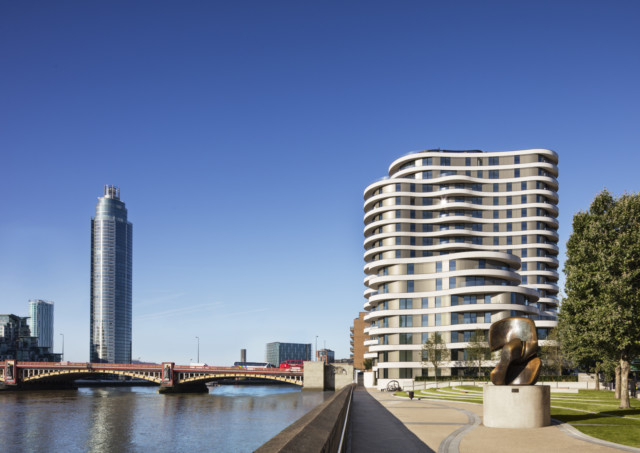
While location has always been a key factor in the property industry, the identity of a city — from London to Hong Kong to Dubai — ultimately defines the architectural projects it plays host to. “Unlike other creative pursuits such as painting, sculpture and music, location is the most important aspect of architecture. Because every site is unique, every building must be unique,” explains David Walker, founder and director of David Walker Architects. Aside from physical attributes, he points out that location lends context to a project, a consideration of its social and economic nature and a fundamental need to find and maintain the “genus loci” — the spirit of a place.
Location
Alan Stanton, director at Stanton Williams, experienced the importance of location most recently in the design of Riverwalk, a luxury apartment development on the north bank of the River Thames. “London, unlike say Paris, is a city of mixed architectural styles, where there is little consistency and yet a strong sense of character and place,” says Walker. This led to a design in which “the form of Riverwalk is different to its neighbours, but as with all Stanton Williams projects the site context is a creative source of ideas. Here in the centre of London, the building was inspired by the River Thames and its urban historical setting.” The finished result’s gently undulating exterior ensures that Riverwalk not only nods to its environment, but also sits harmoniously within it.
An awareness of this environmental context sees the priorities for a design naturally evolve from place to place. Lee Polisano’s firm, PLP Architecture, of which he is president, has worked on a number of projects across the Middle East as well as in London, where the contextual considerations vary vastly. “In London, for example, we are often confronted with a context laced with historically significant buildings as a backdrop for our work,” says Polisano. “On the other hand, in the UAE the climate is often a very strong influence.”
This influence of context can even be strong enough that it becomes the driving force in the project. For Walker, this was the case when he headed the design of The Heron, a City of London residential tower conceptualised to fund the build of a connected concert hall on the same site. The concert hall would act as an extension of the Guildhall School of Music and Drama that had premises in the Barbican, a renowned culture and arts centre just next door.
“Our idea to combine the school with a residential tower [rather than with a commercial office building as initially conceived] was a direct response to the Barbican,” Walker says, “both in terms of physical proximity [the tower is positioned to minimise loss of light for the Barbican apartments], but also its architectural concept by combining academic, cultural and residential uses to create a new kind of urban precinct.”
Limitations
But as each city shapes a project through its cultural, historical and architectural identity, so do these elements generate a unique set of limitations. “London does not have a prescriptive zoning policy,” explains Polisano, “therefore, every site is treated as a unique, one-off design response that requires the architect to win the support of not only the local authorities but also numerous interested third-party stakeholders. This is in contrast to most of the Middle East which has a planning system that defines generally such matters as plot ratio and bulk and mass.”
London and other cities with an abundance of protected historical landmarks are often subject to a number of regulations that, says Stanton, “mould and inform the design process, not the least [of which] are the requirements and aspiration of the local Planning Authority as well as a process that gives all neighbours and stakeholders a say in the design”.
Obtaining these planning permissions can therefore become a lengthy and expensive procedure, he explains. However these limitations that often arise in city settings do not necessarily present problems. As Walker argues, they can instead be the starting point for great design. From his perspective it is “the combination of uses and the proximity to the Barbican that makes The Heron compelling and unique”.
While regulatory challenges are difficult, he contends that they are always understandable. “Buildings can impact profoundly on people’s lives and it is right that great care is taken to ensure that this impact is positive,” says Walker. “It is undoubtedly the case that the limitations imposed by the planning process resulted in a much better building.”
He attributes this to the greater time the planning process can lend to refine and clarify designs, as well as providing architects “with support when proposing changes to the client that improve the building architecturally, though not necessarily commercially”.
From client to context
Client collaboration is indeed a potential challenge arising in another quarter of the design process and Polisano points out that ensuring clients know what they want is essential. His most recent collaboration with Ronson Capital, Chiltern Place, is not his first time working with the team and their knowledge and experience keeps him returning.
“Having a client like that makes the process a challenge, but very enjoyable,” says Polisano. “The Ronson Capital team is very focused and knowledgeable about the type of product it wishes to build. Quality is very high on the agenda and that is very important to me.”
For Stanton Williams, Riverwalk was the first high-end residential project of its kind where the architecture firm was involved in the detailing of the whole of the interior, “right down to the bath taps”.
Stanton also speaks of the importance of finding both a challenge and a shared vision in the collaborative process. “While we do relish the design responsibility the client gave us, the big challenge was to translate that into the exemplary level of built quality we require,” he says. “Happily, we fully shared our client’s aspiration for high quality and attention to detail. We believe every project is only as good as its clients and Riverwalk resulted in a very successful project.”
Even with all these practical considerations — from client to context — perpetually in mind, the process of design nonetheless proves more than functional. Walker “prefers to think of architecture as fundamentally humane, rather than functional”. He explains: “Of course, to be humane it must be functional, but it must also address people’s emotional perceptions as well as their physical perceptions.”
Stanton argues that this emotional perception is an even greater focus on residential developments. “Architecture is about more than mere ‘building’,” he says. “It is about reflecting and expressing our cultural aspirations — [a] building that lifts the spirit and gives us joy. This is even truer of residential projects where ideas of personal self-expression and ‘home’ are key.” Similarly, Polisano stresses the importance of a “strong narrative” in design, shaped around “the way people in the building will choose to live”. All three agree that it is this synthesis of the physical and the emotional that makes for great architecture.
Lessons learnt
With the context, limitations and processes of building development varying so much from city to city, it begs the question whether useful lessons can be learned from international experiences. Polisano takes an evolving perspective on this. With Chiltern Place, “a particularly challenging” project that saw a tall building being incorporated into much lower surroundings, the solution was devising “an architectural language that helped the building’s bulk and mass relate directly to the characteristics of the neighbourhood in material and detail, imbedding the design into the fabric of the area”.
He points out that “while one is usually not challenged in a similar manner when working in cities like Dubai and Abu Dhabi, as these cities continue to develop I can see the need to begin to consider the specifics of such context becoming more and more important”. It is possible, then, that the challenges and ambitions that shape the architects’ projects elsewhere in the world will inevitably become part of the UAE’s landscape as well.













